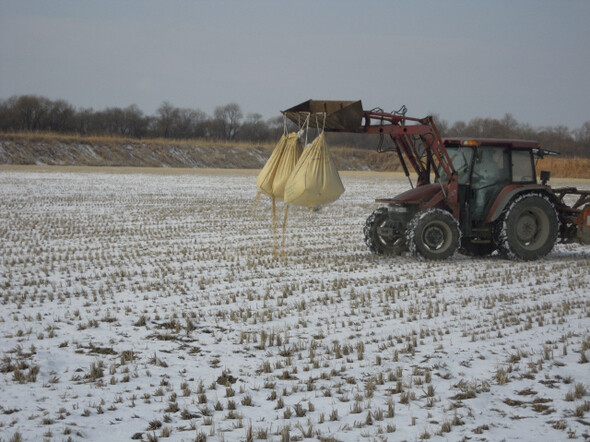hankyoreh
Links to other country sites 다른 나라 사이트 링크
Migratory birds going hungry after bird flu outbreak

By Bang Jun-ho, staff reporter in Goyang
50 migratory birds were gathered near the swamp. Once the reporters approached, they flew off. Approximately 20,000-30,000 migratory birds, included bean goose, spot-billed duck and rare white-naped crane, come to Janghang swamp every year. Janghang swamp stretches 7.49㎢ from Gimpo Bridge in Goyang to Ilsan bridge in Gimpo, Gyeonggi province. Recently there have been fewer birds flying to the area because feedings had been suspended due to an outbreak of avian influenza (AI).
A tractor started its engine on Feb. 9, near Janghang swamp and entered the field in the middle of the swamp carrying a 600 kg bag of rice seed. The bag had holes in the bottom to allow the rice seed to fall to the ground, but the seeds sometimes get clogged inside the bag and don‘t fall evenly.
Hwang Yu-sung, director of Korean Federation of Environmental Movement’s Goyang chapter, said disappointedly, “Unless the seeds are spread by hand, they’ll clump together and get stuck in one area. Strong birds could be able to find the seeds and feed themselves. I’m concerned that there won’t be any left for the weaker birds.”
Goyang City and Korean Federation for Environmental Movement had suspended their twice-a-week feeding of the migratory birds but resumed it on Jan. 28, after the Ministry of Environment issued guidelines for feeding the migratory birds. The birds were not fed by hand to reduce human contact with birds due to concerns of AI infection.
Only a small group participated in the feeding, as it had been scaled down from its previous size: two officials from Goyang City, Hwang, and two soldiers who came along to monitor the swamp, as it is a military zone. Jung Kum-young, an official from Goyang City’s environmental conservation division said, “We have to follow the guideline saying, ‘feed the largest number of birds with the least amount of manpower and human contact.’ We no longer can feed the migratory birds directly by hand, but with a tractor instead. We can only observe the birds being fed.” The officials and soldiers had to wear epidemic control suits, shoes, masks, and gloves. The soldiers had to put their guns down to put the safety suits over their military uniforms.
The tractor spent 20 minutes distributing two sacks worth of rice seeds, zigzagging across the 1700㎡ field. The first species seen in the field was a water deer, which buried its head in the rice seeds for quite a while. Hwang said, “It must have been hungry.”
Goyang City has stopped the feedings not only in Janghang swamp, but also in the nearby mountains. Hwang said, “We’re concerned that birds and animals wouldn’t come to the area because we had suspended the feedings for the past few weeks. Usually, the migratory birds come in the evenings.”
On Feb. 6 and 9, a restricted feeding was held, after the guidelines for feeding migratory birds was released by the Ministry of Environment. Korean Federation for Environmental Movement, animal protection group ‘Kara’, and more fed the migratory birds not only in Janghang swamp but also in Haepyeong swamp in Gumi, North Gyeongsang province and Cheorwon County in Gangwon Province.
Korean Federation of Environmental Movement secretary general Yeom Hyung-chul said, “The government identified migratory birds as the source of the AI outbreak and therefore cut back on feedings. Although the guidelines were set, a lot of local groups are reluctant to feed the birds, so civic groups are handling it.” The feedings will be continued until February 11 in Junam reservoir in Changwon, North Gyeongsang Province and at the mouth of Mankyung River in Jeonju, North Chungcheong Province.

Translated by Kim Hae-yoon, Hankyoreh English intern

Editorial・opinion
![[Column] Life on our Trisolaris [Column] Life on our Trisolaris](https://flexible.img.hani.co.kr/flexible/normal/500/300/imgdb/original/2024/0505/4817148682278544.jpg) [Column] Life on our Trisolaris
[Column] Life on our Trisolaris![[Editorial] Penalties for airing allegations against Korea’s first lady endanger free press [Editorial] Penalties for airing allegations against Korea’s first lady endanger free press](https://flexible.img.hani.co.kr/flexible/normal/500/300/imgdb/original/2024/0502/1817146398095106.jpg) [Editorial] Penalties for airing allegations against Korea’s first lady endanger free press
[Editorial] Penalties for airing allegations against Korea’s first lady endanger free press- [Editorial] Yoon must halt procurement of SM-3 interceptor missiles
- [Guest essay] Maybe Korea’s rapid population decline is an opportunity, not a crisis
- [Column] Can Yoon steer diplomacy with Russia, China back on track?
- [Column] Season 2 of special prosecutor probe may be coming to Korea soon
- [Column] Park Geun-hye déjà vu in Yoon Suk-yeol
- [Editorial] New weight of N. Korea’s nuclear threats makes dialogue all the more urgent
- [Guest essay] The real reason Korea’s new right wants to dub Rhee a founding father
- [Column] ‘Choson’: Is it time we start referring to N. Korea in its own terms?
Most viewed articles
- 160% of young Koreans see no need to have kids after marriage
- 2Presidential office warns of veto in response to opposition passing special counsel probe act
- 3New sex-ed guidelines forbid teaching about homosexuality
- 4Months and months of overdue wages are pushing migrant workers in Korea into debt
- 5OECD upgrades Korea’s growth forecast from 2.2% to 2.6%
- 6[Guest essay] Maybe Korea’s rapid population decline is an opportunity, not a crisis
- 7[Column] Life on our Trisolaris
- 8Another chaebol heir caught smuggling liquid marijuana into South Korea
- 9S. Korea discusses participation in defense development with AUKUS alliance
- 10Bills for Itaewon crush inquiry, special counsel probe into Marine’s death pass National Assembly